ISSN
2307–3489 (Print), ІSSN
2307–6666
(Online)
Наука
та прогрес транспорту. Вісник
Дніпропетровського
національного університету залізничного
транспорту, 2020, № 3 (87)
екологія
Та промислова безпека
UDC
504.5:614.84.027.1
M.
M. BILIAIEV1*,
O. V. Berlov2*,
V.
V. BILIAIEVa3*,
v. a. KOZACHYNA4*,
I.
v. kalashnikov5*
1*Dep.
«Hydraulics and Water Supply», Dnipro National University of
Railway Transport named after Academician V. Lazaryan, Lazaryana St.,
2, Dnipro, Ukraine, 49010, tel. +38 (056) 273 15 09, e-mail
water.supply.treatment@gmail.com, ORCID
0000-0002-1531-7882
2*Dep.
«Life Safety», Prydniprovska State Academy of Civil
Engineering and Architecture, Chernyshevskoho St., 24а, Dnipro,
Ukraine, 49600, tel.
+38 (056) 756-34-57,
e-mail berlov@pgasa.dp.ua, ORCID 0000-0002-7442-0548
3*Dep.
«Fluid Dynamics, Energy and Mass Transfer», Oles Honchar Dnipro
National University, Haharina Av., 72, Dnipro, Ukraine, 49000, tel.
+38 (056) 374 98 22,
e-mail water.supply.treatment@gmail.com, ORCID
0000-0003-2399-3124
4*Dep.
«Hydraulics and Water Supply», Dnipro National University of
Railway Transport named after Academician V. Lazaryan, Lazaryana St.,
2, Dnipro, Ukraine, 49010, tel. +38 (056) 273 15 09, e-mail
v.kozachyna@gmail.com,ORCID
0000-0002-6894-5532
5*Kharkiv
Branch Office «Design and Research Institute of Railway Transport»
of the Ukrainian Railway PJSC, Kotliara St., 7, Kharkiv, 61052, tel.
+38 (057) 724 41 25, e-mail uzp38@ukr.net, ORCID 0000-0002-2814-380
Emergency BURNING of solid rocket
propellant: damage RISK ASSESSMENT
TO PEOPLE in
the workplace
Purpose. This work includes the development of a
computer model to calculate the risk of thermal damage to people in
the shop in case of emergency burning of solid rocket propellant.
Methodology. To calculate the temperature field in the shop in
order to determine the zones of thermal damage to workers in the
building, the equation expressing the law of energy conservation was
used. Based on this modeling equation, the temperature field in the
shop is calculated in the presence of a source of heat emission –
burning solid rocket propellant. To calculate the velocity field of
air flow in the shop, taking into account the location of obstacles
in the path of heat wave propagation, we used the model of
vortex-free air motion – the equation of the velocity potential. A
two-step finite difference scheme of conditional approximation is
used to numerically solve the equation for the velocity potential. A
difference splitting scheme was used to numerically solve the energy
equation. At the first stage of construction of the difference
splitting scheme of the two-dimensional energy equation into the
system of one-dimensional equations is performed. Each
one-dimensional equation allows you to calculate the temperature
change in one coordinate direction. The point-to-point computation
scheme is used to determine the temperature. When conducting a
computational experiment, the air exchange in the building is taken
into account. The risk assessment of thermal damage to personnel in
the building is performed for different probabilities of the place of
emergency combustion of solid rocket propellant. Findings.
Using numerical model prediction of the potential risk areas of
thermal damage to staff in the shop for a variety of emergency
situations was performed. Originality. A computer model for
rapid assessment of the potential risk of damage to people in the
shop in case of emergency burning of solid rocket propellant was
constructed. Practical value. The authors developed a code
that allows you to quickly simulate the temperature fields formation
in the shop in case of emergency burning of solid rocket propellant
and to identify potential areas of thermal damages to workers based
on this information. The developed computer program can be used to
assess the risk of thermal damage in the chemical industry in case of
emergency.
Keywords:
numerical modeling; risk of damage;
emergency burning of solid rocket propellant; thermal pollution of
air
Introduction
Particularly dangerous are
industrial sites, where emergencies are possible with the sudden
formation of intense, diverse impact factors (shock wave, heat wave,
emission of toxic substances). In this case, it is extremely
important to predict the risk of damage to personnel in the
workplace during emergencies.
Analytical
and numerical forecasting methods are used to determine the risk of
personnel damage in case of emergencies [3, 6–15]. These methods
are focused on assessing the risk of toxic damage to humans during
accidental releases of toxic substances. At the same time, the task
of predicting the risk of thermal damage to people during
emergencies is also relevant. This is especially important in cases
where there is a fire inside industrial shops with a significant
number of workers. The risk of thermal damage may occur, for
example, in the event of emergency ignition of solid rocket
propellant in the shops. The temperature of the combustion products
of solid rocket propellants is very high. Due to the high emission
of heated propellant combustion products, the area of thermal
contamination spreads across the shop and there is a risk of thermal
damage to personnel in the work areas. To assess the risk of thermal
damage to personnel, it is necessary to have mathematical models.
Purpose
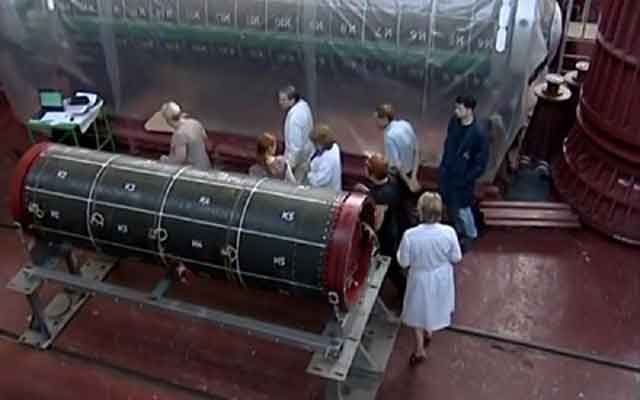
Fig.
1. Solid propellant engine of Thunder-2 rocket
in the working
room
(https://allkharkov.ua/news/state/grom-grianet-v-etom-gody.html)
The paper envisages the
development of a numerical model for assessing the risk of
thermal damage to people in the workplace in the event of emergency
burning of solid rocket propellant (SRP) for Thunder-2 rocket (Fig.
1).
Methodology
To assess the risk of thermal
damage to people in the workplace in the event of emergency burning
of solid rocket propellant, we will use the equation of convective
heat transfer (two-dimensional, planned model, Boussinesq
approximation) [4, 7]:
 (1)
(1)
where
 – is
the air temperature;
– is
the air temperature;
 – components of the air velocity vector in the building;
– components of the air velocity vector in the building;
 – temperature conductivity coefficients;
– temperature conductivity coefficients;
 – Cartesian coordinates;
– Cartesian coordinates;
 – time.
– time.
Statement of boundary
conditions for energy equation (1) is as follows [7]:
1. At the entrance to the
calculation area:
 ,
,
where
 – known air temperature (for example,
– known air temperature (for example,
 ).
).
2. At the boundary of the
outflow of the calculation area:
 ,
,
where
 – temperature in the last difference cell;
– temperature in the last difference cell;
 – the temperature in the previous cell.
– the temperature in the previous cell.
3. On
the hard boundaries

For the
moment of time
 ,
i.e. at the beginning of the calculation, we set the condition
,
i.e. at the beginning of the calculation, we set the condition
 ,
where
,
where
 is the known air temperature in the calculation area, for example
is the known air temperature in the calculation area, for example
 .
The temperature of burning products is set at the place of solid
propellant combustion [7].
.
The temperature of burning products is set at the place of solid
propellant combustion [7].
By solving equation (1) we can
determine the temperature distribution in the working areas in the
shop. The important thing is that one can obtain a non-steady
solution to the problem – the data of changes in the temperature
distribution in the shop over time. The risk of thermal damage [7]
is determined from the following condition: if the air temperature
in the working area is more than 100 ºC, at which there is a
complete protein denaturation, then at this point in the working
area it is assumed that the risk of damage is 100 %.
To numerically solve equation
(1), we split the energy equation at the differential level into a
sequence of such equations [5, 7]:
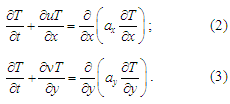
Next, we use a non-explicit
difference scheme to numerically integrate one-dimensional energy
equations [5, 7]. Let us perform the following transformations:

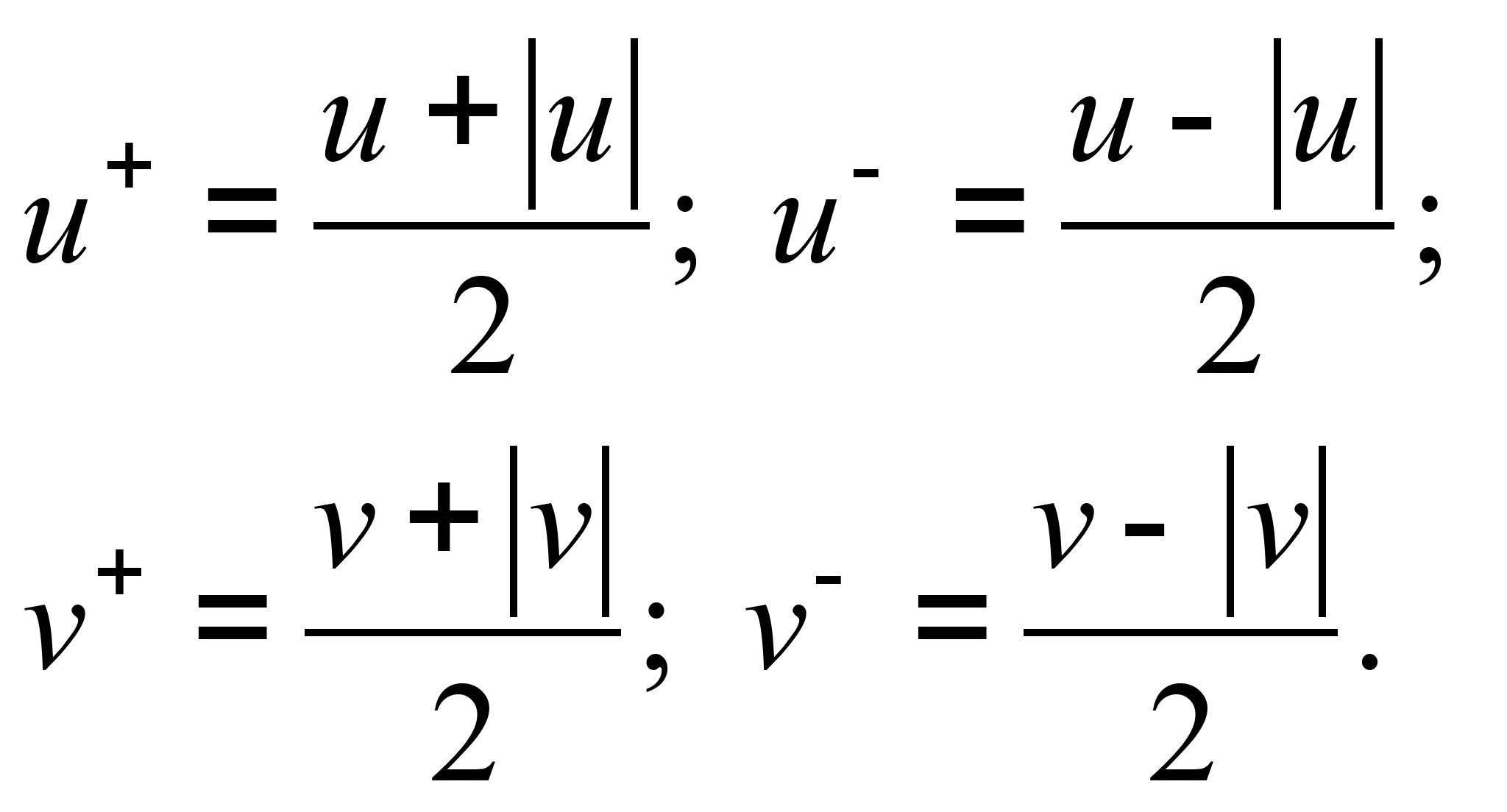
Let us perform further
approximation of derivatives for equations from system (2), (3) [7]:
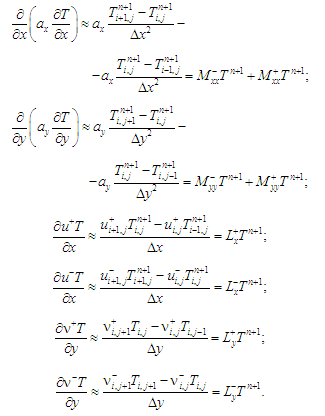
The splitting scheme for
equation (2) is written as follows [5, 7]:
– in
the first step, the difference equation has the form:
 (4)
(4)
– in
the second step, the difference equation takes the form:
 (5)
(5)
The splitting scheme for
numerical integration of equation (3) will be as follows:
– in
the first step we obtain the difference equation:
 (6)
(6)
– in
the second step of splitting, the difference equation will have the
form:
 (7)
(7)
The unknown
value of temperature T
at each splitting step (4) – (7) is calculated by the formula of
the point-to-point computation.
The air
velocity field u, v,
in the presence of obstacles at the
industrial site, is determined based on the model of the movement
potential [2, 3, 7]:
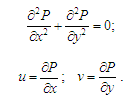 (8)
(8)
The boundary conditions for
equation (8) are as follows [2, 3, 7]:
1)  – on the hard boundaries;
– on the hard boundaries;
2)  – at the boundary where the flow enters through the ventilation
system,
– at the boundary where the flow enters through the ventilation
system,
 – is the known
air velocity;
– is the known
air velocity;
3) P
= const – at the boundary of the
outflow of the calculation area.
To numerically solve this
equation, we will use the scheme of conditional approximation [5].
The difference splitting equations in this case are as follows [5]:
– in the
first step of splitting:
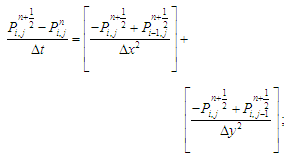 (9)
(9)
– in the
second step of splitting:
 (10)
(10)
Unknown
values of the velocity potential
 ,
,
 in each splitting step (9), (10) are determined by the method of
point-to-point computation.
in each splitting step (9), (10) are determined by the method of
point-to-point computation.
The calculation according to
dependences (9), (10) ends when [7]:

where
 – the value of the velocity potential on the new iteration;
– the value of the velocity potential on the new iteration;
 – the value of the velocity potential on the previous iteration; ε
– small number.
– the value of the velocity potential on the previous iteration; ε
– small number.
To start the
calculation it is necessary to set the «initial» value of the
velocity potential in the calculation area, during the calculation
we take the value .
.
The components of the air
velocity vector are calculated on the sides of the computational
cell as follows [3, 7]:

After calculating the velocity
component, we perform the solution of the energy equation where this
field is used.
Let us consider the algorithm
for solving the problem of determining the potential risk of thermal
damage to personnel in the shop [1, 2, 7]. First, based on numerical
integration of fundamental equations (energy equations and equations
for velocity potential) we perform the calculation of the
temperature distribution in the shop for different emergencies. When
assessing the risk, we assume that the probability of each emergency
is known. After calculating the temperature field for different
accident scenarios in the shop, the computer program determines the
areas where the value of air temperature is greater than the
temperature of the damage.
Then we print the forecast
results of the thermal damage risk for a certain time point. In this
article the various probability of fire point of rocket propellant
in shop is considered.
The numerical solution of all
difference equations has been programmed. FORTRAN was used to create
computer code to simulate the process of thermal air pollution.
Findings
The constructed numerical model
was used to assess the potential risk of thermal damage to people in
the shop where the solid rocket propellant of Thunder-2 rocket is
located. In the event of emergency that leads to the burning of
solid rocket propellant inside the shop, there may be a «domino»
effect – the ignition of the propellant of a neighboring rocket
engine.
The scheme
of the calculation area is shown in Fig. 2. The arrow in the Figure
shows the direction of air movement in the shop. During the
calculations, the task was set to determine the level of temperature
pollution in the shop over time and in the working area (position
no. 2 in Fig. 2). The air exchange rate in the shop is equal to кр
= 15. The initial air temperature in
the shop is 20 ºС. We assumed that the temperature of combustion
products at the accident site is equal to 1 000 ºC [7]. For the
calculations, the influence of the engine housings in the shop on
the formation of temperature fields was taken into account. Below
Fig. 3 and 4 show the changes dynamics in air temperature in the
shop for different time periods after the emergency.
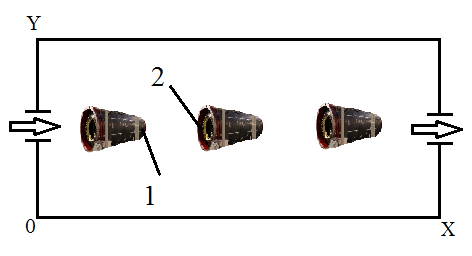
Fig.
2. Scheme of the calculation area:
1
– fire point of propellant in the shop;
2
– solid propellant engines of the Thunder-2 rocket
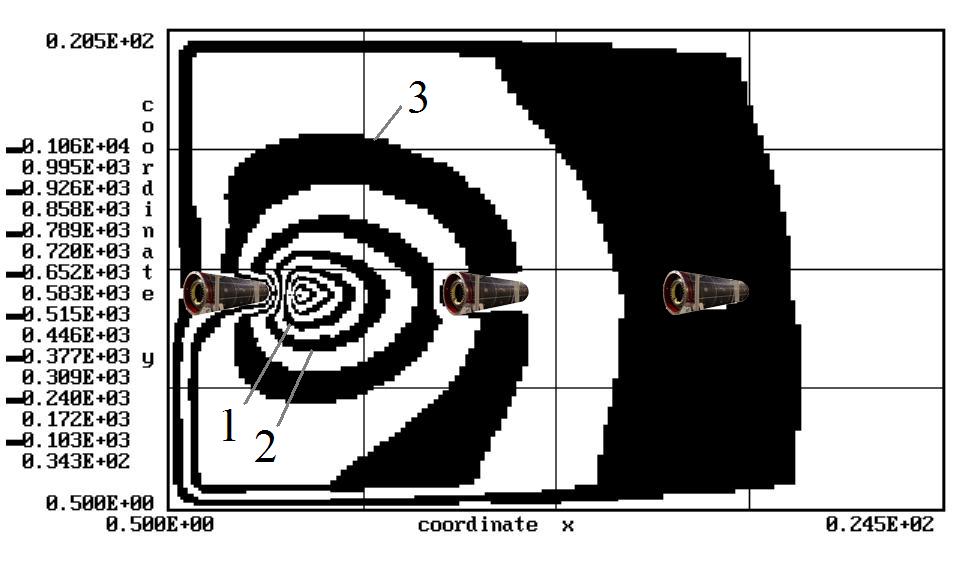
Fig. 3. Zone of thermal pollution
(isotherms)
inside the shop, t = 11 sec:
1
– T = 789 ºС; 2 – T=625 ºС; 3 – T = 377 ºС
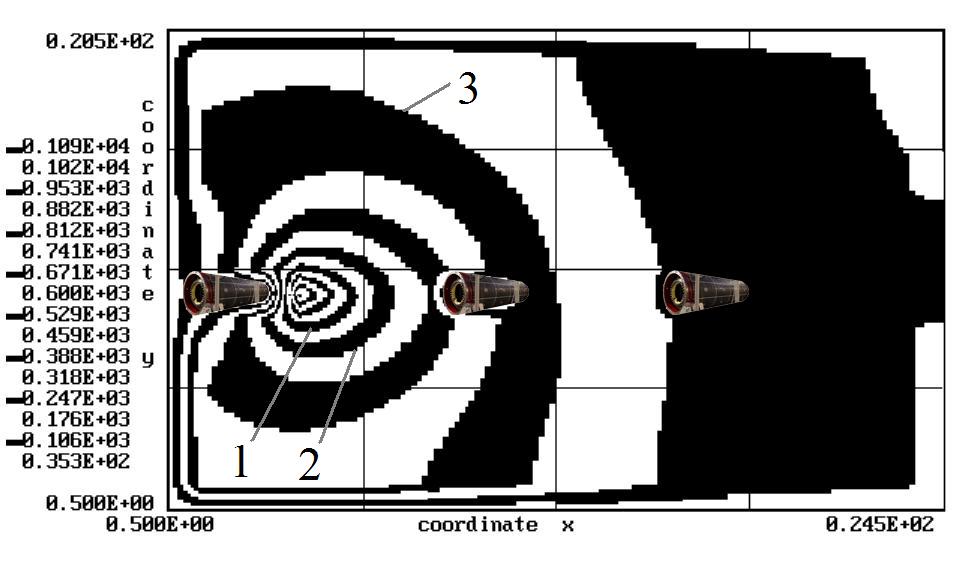
Fig. 4. Zone of thermal pollution
(isotherms)
inside the shop, t = 15 sec:
1
– T = 812 ºС; 2
– T = 671 ºС; 3
– T = 388 ºС
The analysis of the given
Figures shows that the thermal pollution zone is formed very quickly
in the shop. A zone with a high temperature gradient is formed near
the emission source.
Fig. 5 shows the temperature
change over time in the working area.
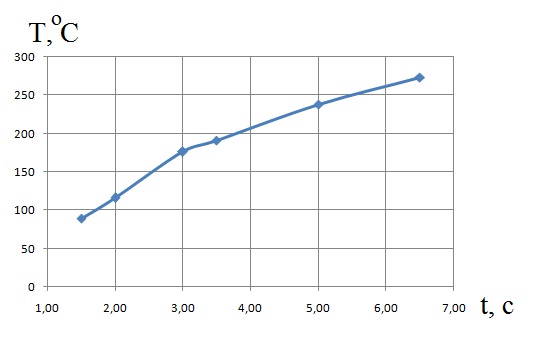
Fig.
5. Change in air temperature over time
in the working area
As we can see from the Figure,
the air temperature rises very quickly in the working area. In 7
seconds it almost reaches the value of 270 ºC, i.e. there is a risk
not only of thermal damage to personnel, but also of a «domino»
effect – ignition of a neighboring rocket engine, which is located
at a distance of 5 m from the engine where the fire started.
Fig. 7, 8 show the results of solving another problem to assess the
risk of thermal damage to personnel in the shop. The situation when
several solid propellant engines are located in the shop is
considered (Fig. 6), and the further probability of emergency –
the probability of engine ignition in zone no. 1 is 25 %, and in
zone no. 2 – 75 %.
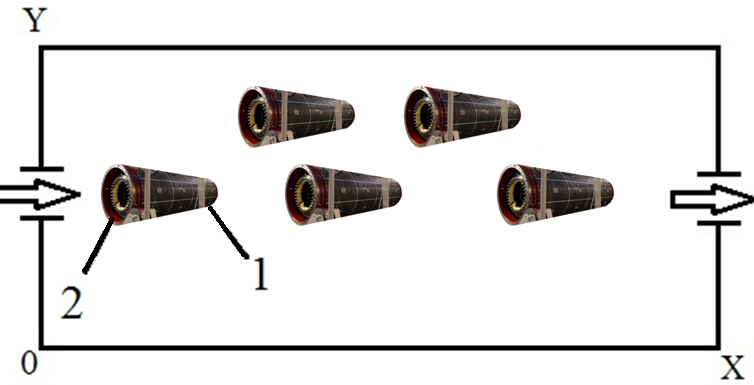
Fig.
6. Scheme of the calculation area (shop where solid propellant
engines are located):
1
– fire point no. 1 (fire probability 25 %);
2
– fire point no. 2 (fire probability 75 %)
Fig. 7, 8 show the matrix of
potential territorial risk of thermal damage to people in the shop
for different points in time in the case of the realization of these
probable situations.
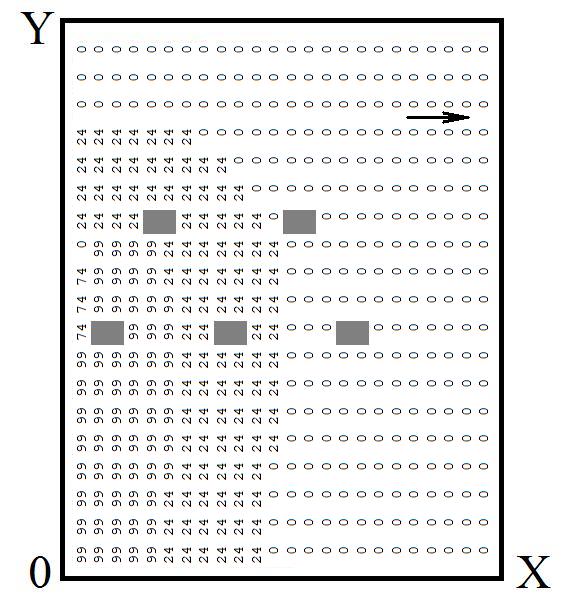
Fig.
7. The probability of thermal damage
to personnel in the shop at
time t = 12 sec
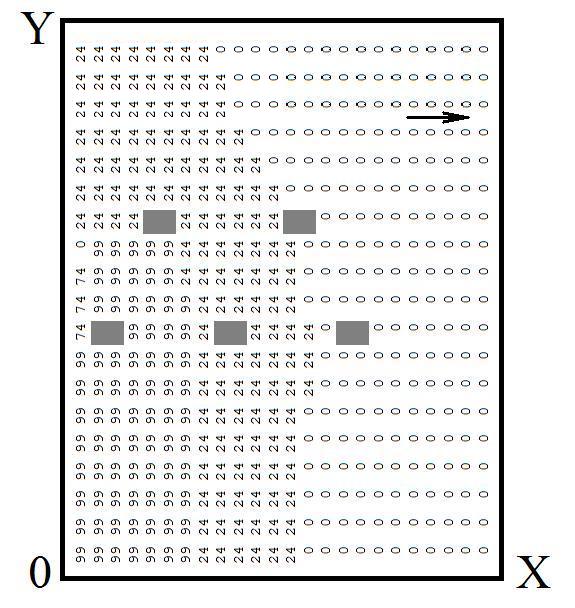
Fig.
8. The probability of thermal damage
to personnel in the shop at
time t = 24 sec
As we can see from the given
Figures, for the considered situations the risk of thermal damage to
the personnel in the shop is extremely high, because the zone of
thermal damage is formed very quickly.
It should be noted that it took
about 5 seconds computer time to solve the problem.
Originality
and practical value
A computer model has been built
to quickly assess the potential risk of thermal damage to people in
the shop in the event of emergency ignition of solid rocket
propellant. A code has been developed that allows to quickly model
the formation of temperature fields in the shop in case of emergency
ignition of solid rocket propellant and to determine the areas of
potential thermal damage to workers based on this information.
The developed computer program
can be used to assess the risk of thermal damage in the chemical
industry in the event of emergency.
Conclusions
1. A computer model has
been proposed to predict the risk of thermal damage to shop workers
in the event of emergency that results in the ignition of solid
rocket propellant.
2. Based on computer
simulation data, it can be concluded that in the event of emergency
in the shop, there will be lethal thermal damage to workers.
3. The formation of thermal
damage zones in the shop is very quickly, so it is necessary to
develop measures to save the lives of workers.
LIST OF REFERENCE
LINKS
Алымов В. Т.,
Тарасова Н. П. Техногенный
риск. Анализ и оценка : учеб.
пособие для вузов. Москва : Академкнига,
2004. 118 с.
Беляев
Н. Н., Гунько Е. Ю., Кириченко П. С., Мунтян
Л. Я. Оценка
техногенного риска при эмиссии опасных
веществ на железнодорожном транспорте.
Кривой Рог : Р. А. Козлов, 2017. 127 с.
Згуровский
М. З., Скопецкий В. В., Хрущ В. К., Беляев
Н. Н. Численное моделирование
распространения загрязнения в окружающей
среде. Киев : Наук. думка, 1997. 368 с.
Марчук Г. И.
Математическое моделирование в
проблеме окружающей среды. Москва :
Наука, 1982. 320 с.
Самарский
А. А. Теория разностных схем. Москва
: Наука, 1983. 616 с.
Berlov
O. V. Atmosphere protection in case of emergency during
transportation of dangerous cargo. Наука та
прогрес транспорту. 2016. № 1 (61). С.
48–54. DOI:
https://doi.org/10.15802/stp2016/60953
Biliaiev
M. M., Berlov O. V., Kozachina V. A., Kalashnikov I. V., Shevchenko
O. V. Risk assessment of thermal damage to people at industrial
sites in case of emergency of burning solid propellant. Наука
та прогрес транспорту.
2020. № 1 (85).
С. 7–16.
DOI: 10.15802/stp2020/200752
Biliaiev
M. M., Kharytonov M. M. Numerical Simulation of Indoor Air
Pollution and Atmosphere Pollution for Regions Having Complex
Topography. NATO Science for Peace and
Security. Series
C : Environmental Security.
Dordrecht, 2012. P. 87–91. DOI:
10.1007/978-94-007-1359-8_15
Boris
J., Patnaik G., Obenschain K., Moses A., Obenschain M.-Y., Theodore
Y., Delaney J., Donnelly J. Fast and accurate prediction of
windborne contaminant plumes for civil defense in cities. The
Fifth International Symposium on Computational Wind Engineering
(CWE2010). 2010. P. 1–9.
Cao
C., Li C., Yang Q., Zhang F. Multi-Objective Optimization Model of
Emergency Organization Allocation for Sustainable Disaster Supply
Chain. Sustainability.
2017. Vol. 9. Іss.
11. P. 1–22.
DOI: 10.3390/su9112103
Ilić
P., Ilić S., Stojanović Bjelić L.
Hazard modelling of accidental release chlorine gas using modern
tool-aloha software. Quality of Life
(Banja Luka) - APEIRON. 2018. Vol.
16. Iss. 1–2. P. 38–45.
DOI: 10.7251/QOL1801038I
Komatina
D. Ilić, Galjak J., Belošević S. Simulation of chemical
accidents with acetylene in «messer tehnogas» kraljevo plant by
«aloha» software program. The
University Thought - Publication in Natural Sciences.
2018. Vol. 8. Iss. 2.
P. 19–26. DOI: 10.5937/univtho8-18014
Lacome
J.-M., Truchot D., Duplantier S. Application
of an innovative risk dedicated procedure for both conventional and
3D atmospheric dispersion models evaluation.
18 International Conference on
Harmonisation within Atmospheric Dispersion Modelling for
Regulatory Purposes (HARMO
18) (Bologne, Oct 2017). Bologne,
2017. P. 821–825.
Lee
H., Sohn J.-R., Byeon S.-H., Yoon S., Moon K.
Alternative Risk Assessment for Dangerous Chemicals in South Korea
Regulation : Comparing Three Modeling Programs. Int.
J. Environ. Res. Public Health. 2018.
Vol. 15. Iss. 8. Р. 1–12. DOI:
10.3390/ijerph15081600
Sideris
G. M., Christolis M. N., Markatos. N. C. Numerical simulation of
pollutants dispersion around an electric-arc-furnace in case of an
accidental release. Biodiversity
International Journal. 2020.
Vol. 4. Iss. 1.
P. 50‒57.
DOI: 10.15406/bij.2020.04.00164
М.
М.
БІЛЯЄВ1*,
о.
в.
БЕРЛОВ2*,
В. В. БІЛЯЄВА3*,
в.
А.
козачина4*,
І. В. калашніков5*
1*Каф.
«Гідравліка та водопостачання»,
Дніпровський національний університет
залізничного транспорту імені академі-ка
В. Лазаряна, вул. Лазаряна, 2, Дніпро,
Україна, 49010, тел. +38 (056) 273 15 09, ел. пошта
water.supply.treatment@gmail.com,
ORCID 0000-0002-1531-7882
2*Каф.
«Безпека життєдіяльності», ДВНЗ
Придніпровська державна академія
будівництва та архітектури, вул.
Чернишевського, 24а, Дніпро, Україна,
49600, тел. +38 (056) 756 34 57, ел. пошта
berlov.oleksandr@pgasa.dp.ua,
ORCID 0000-0002-7442-0548
3*Каф.
«Аерогідромеханіка та
тепломасоперенос», Дніпровський
національний університет імені Олеся
Гончара, просп. Гагаріна, 72, Дніпро,
Україна, 49000, тел. +38 (056) 374 98 22, ел. пошта
water.supply.treatment@gmail.com, ORCID
0000-0003-2399-3124
4*Каф.
«Гідравліка та водопостачання»,
Дніпровський національний університет
залізничного транспорту імені академіка
В. Лазаряна, вул. Лазаряна, 2, Дніпро,
Україна, 49010, тел. +38 (056) 273 15 09, ел. пошта
v.kozachyna@gmail.com,
ORCID 0000-0002-6894-5532
5*Харківське
відділення філії «Проєктно-вишукувальний
інститут залізничного транспорту» АТ
«Українська залізниця», вул. Котляра,
7, Харків, Україна, 61052, тел. +38 (057) 724 41 25,
ел. пошта uzp38@ukr.net, ORCID 0000-0002-2814-380X
аварійнЕ горіння
твердого ракетного
палива:
ОЦІНКА РИЗИКУ УРАЖЕННЯ
ЛЮДЕЙ В РОБОЧОМУ
ПРИМІЩЕННІ
Мета.
Ця робота передбачає розробку комп’ютерної
моделі для розрахунку ризику термічного
ураження людей у цеху в разі аварійного
горіння твердого ракетного палива.
Методика.
Для розрахунку поля температури в цеху,
з метою визначення зон термічного
ураження працівників у приміщенні,
використано рівняння, що виражає закон
збереження енергії. На базі цього
моделювального рівняння розраховано
поле температур у цеху за наявності
джерела емісії тепла – твердого
ракетного палива, що горить. Розрахунок
поля швидкості повітряного потоку в
цеху, з урахуванням розташування
перешкод на шляху розповсюдження
теплової хвилі, проведено на базі моделі
безвихрового руху повітря – рівняння
потенціалу швидкості. Чисельне
розв’язання рівняння для потенціалу
швидкості виконано за допомогою
двокрокової скінченнорізницевої схеми
умовної апроксимації. Для чисельного
розв’язання рівняння енергії використано
різницеву схему розщеплення. На першому
етапі побудови різницевої схеми виконано
розщеплення двовимірного рівняння
енергії на систему одновимірних рівнянь.
Кожне одновимірне рівняння дозволяє
розрахувати зміну температури в одному
координатному напрямку. Для визначення
температури використано схему біжучого
рахунку. Під час проведення обчислювального
експерименту враховано повітрообмін
у приміщенні. Оцінку ризику термічного
ураження персоналу в приміщенні виконано
для різних вірогідностей місця аварійного
горіння твердого ракетного палива.
Результати.
За допомогою розробленої чисельної
моделі виконано прогнозування зон
потенціального ризику термічного
ураження персоналу в цеху для різних
аварійний ситуацій. Наукова
новизна. Побудовано
комп’ютерну модель для експрес-оцінки
потенціального ризику термічного
ураження людей в цеху в разі аварійного
горіння твердого ракетного палива.
Практична значимість.
Розроблено код, що
дозволяє швидко моделювати формування
температурних полів у цеху у випадку
аварійного горіння твердого ракетного
палива, та на базі цієї інформації
визначати зони потенціального термічного
ураження працівників. Розроблена
комп’ютерна програма може бути
використана для оцінки ризику термічного
ураження на підприємствах хімічної
промисловості в разі виникнення
аварійних ситуацій.
Ключові слова:
чисельне моделювання;
ризик ураження;
аварійне горіння твердого ракетного
палива;
теплове забруднення повітря
Н.
Н. БЕЛЯЕВ1*,
А. В. БЕРЛОВ2*,
В. в. беляева3*,
В. А.
козачина4*,
И. В. калашников5*
1*Каф.
«Гидравлика и водоснабжение», Днипровский
национальный университет железнодорожного
транспорта имени академика В. Лазаряна,
ул. Лазаряна, 2, Днипро, Украина, 49010, тел.
+38 (056) 273 15 09, эл. почта
water.supply.treatment@gmail.com, ORCID 0000-0002-1531-7882
2*Каф.
«Безопасность жизнедеятельности»,
ГВУЗ Приднепровская государственная
академия строительства и архитектуры,
ул. Чернышевского, 24а, Днипро, Украина,
49600, тел. +38 (056) 756 34 57, эл. почта
berlov@pgasa.dp.ua,
ORCID 0000-0002-7442-0548
3*Каф.
«Аэрогидромеханика и энергомасоперенос»,
Днипровский национальный университет
имени Олеся Гончара, просп. Гагарина,
72, Днипро, Украина, 49000, тел. +38 (056) 374 98
22, эл. почта water.supply.treatment@gmail.com, ORCID
0000-0003-2399-3124
4*Каф.
«Гидравлика и водоснабжение», Днипровский
национальный университет железнодорожного
транспорта имени академика В. Лазаряна,
ул. Лазаряна, 2, Днипро, Украина, 49010, тел.
+38 (056) 273 15 09, эл. почта v.kozachyna@gmail.com,
ORCID 0000-0002-6894-5532
5*Харьковское
отделение филиала «Проектно-изыскательный
институт железнодорожного транспорта»
АО «Українська залізниця»,
ул. Котляра, 7, Харьков, Украина, 61052, тел.
+38 (057) 724 41 25, эл. почта uzp38@ukr.net, ORCID
0000-0002-2814-380X
АВАРИЙНОЕ ГОРЕНИе твердого
ракетного
топлива: ОЦЕНКА РИСКА ПОРАЖЕНИЯ
ЛЮДЕЙ В РАБОЧЕМ ПОМЕЩЕНИИ
Цель. Эта
работа предусматривает разработку
компьютерной модели для расчета риска
термического поражения людей в цехе
при аварийном горении твердого ракетного
топлива. Методика. Для
расчета поля температуры в цехе, с целью
определения зон термического поражения
работников в помещении, использовано
уравнение, выражающее закон сохранения
энергии. На базе этого моделирующего
уравнения рассчитано поле температур
в цехе при наличии источника эмиссии
тепла – горящего твердого ракетного
топлива. Расчет поля скорости воздушного
потока в цехе, с учетом расположения
препятствий на пути распространения
тепловой волны, проведен на базе модели
безвихревого движения воздуха –
уравнения потенциала скорости. Численное
решение уравнения для потенциала
скорости выполнено с помощью двухшаговой
конечноразностной схемы условной
аппроксимации. Для численного решения
уравнения энергии использована
разностная схема расщепления. На первом
этапе построения разностной схемы
выполнено расщепление двумерного
уравнения энергии на систему одномерных
уравнений. Каждое одномерное уравнение
позволяет рассчитать изменение
температуры в одном координатном
направлении. Для определения температуры
использована схема бегущего счета. При
проведении вычислительного эксперимента
учтен воздухообмен в помещении.
Оценку риска термического поражения
персонала в помещении выполнено для
различных вероятностей места аварийного
горения твердого ракетного топлива.
Результаты. С
помощью разработанной численной модели
выполнено прогнозирование зон
потенциального риска термического
поражения персонала в цехе для различных
аварийный ситуаций. Научная
новизна. Построена
компьютерная модель для экспресс-оценки
потенциального риска термического
поражения людей в цехе в случае аварийного
горения твердого ракетного топлива.
Практическая значимость.
Разработан код, позволяющий быстро
моделировать формирования температурных
полей в цехе при аварийном горении
твердого ракетного топлива, и на базе
этой информации определять зоны
потенциального термического поражения
работников. Разработанная компьютерная
программа может быть использована для
оценки риска термического поражения
на предприятиях химической промышленности
в случае возникновения аварийных
ситуаций.
Ключевые слова: численное
моделирование; риск поражения; аварийное
горение твердого ракетного топлива;
тепловое загрязнение воздуха
References
Alymov,
V. T., & Tarasova, N. P. (2004). Tekhnogennyy
risk. Analiz i otsenka: uchebebnoe
posobie dlya vuzov.
Moscow:
Akademkniga. (in Russian)
Belyaev,
N. N., Gunko, Y. Y., Kirichenko, P. S., & Muntyan, L. Y.
(2017). Otsenka tekhnogennogo riska
pri emissii opasnykh veshchestv na zheleznodorozhnom transporte.
Krivoi Rog: Kozlov R. A. (in Russian)
Zgurovskiy,
M. Z., Skopetskiy, V. V., Khrushch, V. K., & Belyaev, N. N.
(1997). Chislennoe
modelirovanie rasprostraneniya zagryazneniya v okruzhayushchey
srede.
Kуiv:
Naukova dumka. (in
Russian)
Marchuk,
G. I. (1982). Matematicheskoye
modelirovaniye v probleme okruzhayushchey sredy.
Moscow: Nauka. (in Russian)
Samarskij,
A. A. (1983). Teoriya raznostnyh
skhem. Moscow:
Nauka. (in Russian)
Berlov,
O. V. (2016). Atmosphere protection in case of emergency during
transportation of dangerous cargo.
Sciance
and Transport Progress, 1(61),
48-54.
DOI: 10.15802/stp2016/60953
(in
English)
Biliaiev,
M. M., Berlov, O. V., Kozachina, V. A., Kalashnikov, I. V. &
Shevchenko, O. V. (2020). Risk assessment
of thermal damage to people at industrial sites in case of
emergency of burning solid propellant. Sciance
and Transport Progress, 1(85),
7-16. DOI:
10.15802/stp2020/200752 (in English)
Biliaiev,
M. M., & Kharytonov, M. M. (2012). Numerical Simulation of
Indoor Air Pollution and Atmosphere Pollution for Regions Having
Complex Topography. NATO
Science for Peace and Security. Series C: Environmental Security,
87-91. DOI:
10.1007/978-94-007-1359-8_15 (in English)
Boris,
J., Patnaik, G., Obenschain, K., Moses, A., Obenschain, M.-Y.,
Theodore, Y., Delaney, J. & Donnelly, J. (2010). Fast
and accurate prediction of windborne contaminant plumes for civil
defense in cities. The
Fifth International Symposium on Computational Wind Engineering
(CWE2010), 1-9.
(in English)
Cao,
C., Li, C., Yang, Q., & Zhang, F. (2017). Multi-Objective
Optimization Model of Emergency Organization Allocation for
Sustainable Disaster Supply Chain.
Sustainability,
9(11),
1-22.
DOI: 10.3390/su9112103
(in English)
Ilić,
P., Ilić,
S., &
Stojanović
Bjelić, L.
(2018). Hazard Modelling of Accidental
Release Chlorine Gas Using Modern Tool-Aloha Software. Quality
of Life (Banja Luka)-APEIRON, 16(1-2),
38-45. DOI: 10.7251/QOL1801038I
(in English)
Komatina,
D. Ilić, Galjak, J., Belošević, S. (2018). Simulation of
chemical accidents with acetylene in «messer tehnogas» kraljevo
plant by «aloha» software program. The
University Thought-Publication in Natural Sciences,
8(2),
19-26. DOI: 10.5937/univtho8-18014 (in English)
Lacome,
J. M., Truchot, D. & Duplantier S. (2017). Application
of an innovative risk dedicated procedure for both conventional and
3D atmospheric dispersion models evaluation.
8 International Conference on
Harmonisation within Atmospheric Dispersion Modelling for
Regulatory Purposes (HARMO 18) (pp.
821-825). Bologne, Italy. (in English)
Lee,
H., Sohn, J.-R., Byeon, S.-H., Yoon, S., & Moon, K. (2018).
Alternative Risk Assessment for Dangerous Chemicals in South Korea
Regulation: Comparing Three Modeling Programs. International
Journal of Environmental Research and Public Health, 15(8),
1-12.
DOI: 10.3390/ijerph15081600 (in English)
Sideris,
G. M., Christolis, M. N., Markatos, N. C. (2020). Numerical
simulation of pollutants dispersion around an electric-arc-furnace
in case of an accidental release. Biodiversity
International Journal, 4(1), 50-57.
DOI: 10.15406/bij.2020.04.00164 (in
English)
Received:
January 30, 2020
Accepted:
June 02, 2020
(1)
– is
the air temperature;
– components of the air velocity vector in the building;
– temperature conductivity coefficients;
– Cartesian coordinates;
– time.
,
– known air temperature (for example,
).
,
– temperature in the last difference cell;
– the temperature in the previous cell.
,
i.e. at the beginning of the calculation, we set the condition
,
where
is the known air temperature in the calculation area, for example
.
The temperature of burning products is set at the place of solid
propellant combustion [7].
(4)
(5)
(6)
(7)
(8)
– on the hard boundaries;
– at the boundary where the flow enters through the ventilation
system,
– is the known
air velocity;
(9)
(10)
,
in each splitting step (9), (10) are determined by the method of
point-to-point computation.
– the value of the velocity potential on the new iteration;
– the value of the velocity potential on the previous iteration; ε
– small number.
.